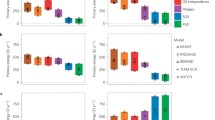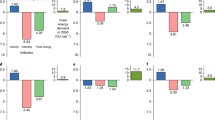Abstract
Energy efficiency is one of the main options for mitigating climate change. An accurate representation of various mechanisms of energy efficiency is vital for the assessment of its realistic potential. Results of a questionnaire show that the EMF27 models collectively represent known channels of energy efficiency reasonably well, addressing issues of energy efficiency barriers and rebound effects. The majority of models, including general equilibrium models, have an explicit end-use representation for the transportation sector. All participating partial equilibrium models have some capability of reflecting the actual market behavior of consumers and firms. The EMF27 results show that energy intensity declines faster under climate policy than under a baseline scenario. With a climate policy roughly consistent with a global warming of two degrees, the median annual improvement rate of energy intensity for 2010–2030 reaches 2.3 % per year [with a full model range of 1.3–2.9 %/yr], much faster than the historical rate of 1.3 % per year. The improvement rate increases further if technology is constrained. The results suggest that the target of the United Nations’ “Sustainable Energy for All” initiative is consistent with the 2-degree climate change target, as long as there are no technology constraints. The rate of energy intensity decline varies significantly across models, with larger variations at the regional and sectoral levels. Decomposition of the transportation sector down to a service level for a subset of models reveals that to achieve energy efficiency, a general equilibrium model tends to reduce service demands while partial equilibrium models favor technical substitution.






Similar content being viewed by others
Notes
These numbers exclude the transportation sector. They also note significant negative-cost energy efficiency opportunities.
This approach of estimating an aggregate service demand is not without problems. By converting energy service into energy units, the economic value of each service demand type is ignored. Alternatively, it is possible to use certain economic measures (e.g., shadow prices) as weights, but such an analysis is left for future work.
References
Allcott H, Greenstone M (2012) Is there an energy efficiency gap? J Econ Perspect 26:3–28. doi:10.1257/jep.26.1.3
Barker T et al. (2007) Mitigation from a cross-sectoral perspective. In: Metz B, Davidson O, Bosch PR, Dave R, Meyer LA (eds) Climate change 2007: mitigation. Contribution of Working Group II to the Fourth Assessment Report of the Intergovernmental Panel on Climate Change. Cambridge University Press, Cambridge, UK
Fisher BS et al. (2007) Issues related to mitigation in the long term context. In: Metz B, Davidson OR, Bosch PR, Dave R, Meyer LA (eds) Climate change 2007: mitigation. Contribution of Working Group III to the Fourth Assessment Report of the Intergovernmental Panel on Climate Change. Cambridge University Press, Cambridge, UK
GEA (2012) Global energy assessment – toward a sustainable future. Cambridge University Press, Cambridge UK and New York, NY, USA and the International Institute for Applied Systems Analysis, Laxenburg, Austria
Gillingham K, Kotchen MJ, Rapson DS, Wagner G (2013) The rebound effect is overplayed. Nature 493:475–476. doi:10.1038/493475a
Hanaoka T, Kawase R, Kainuma M, Matsuoka Y, Ishii H, Oka K (2006) Greenhouse gas emissions scenarios database and regional mitigation analysis. NIES, Tsukuba
Hanaoka T, Kainuma M, Matsuoka Y (2009) The role of energy intensity improvement in the AR4 GHG stabilization scenarios. Energy Efficiency 2:95–108. doi:10.1007/s12053-009-9045-y
Hanaoka T, Kainuma M, Oka K, Ishii H (2011) Greenhouse gases emissions scenarios database: contribution to the IPCC assessment reports. NIES, Tsukuba
Hourcade J, Jaccard M, Bataille C, Ghersi F (eds) (2006) Hybrid modeling of energy-environment policies: Reconciling bottom-up and top-down. The Energy J, special issue
Howarth RB, Sanstad AH (1995) Discount rates and energy efficiency. Contemp Econ Policy 13:101–109. doi:10.1111/j.1465-7287.1995.tb00726.x
Huntington H (2011) The policy implications of energy-efficiency cost curves. The Energy J, special issue. doi:10.5547/ISSN0195-6574-EJ-Vol32-SI1-2
Huntington H, Smith E (2011) Mitigating climate change through energy efficiency: an introduction and overview. The Energy J, special issue. doi:10.5547/ISSN0195-6574-EJ-Vol33-SI1-1
Jenkins J, Nordhaus T, Shellenberger M (2011) Energy emergence: rebound and backfire as emergent phenomena. Breakthrough Institute, Oakland
Krey V, Luderer G, Clarke L (2013) Getting from here to there – energy technology transformation pathways in the EMF-27 scenarios. Climatic Change, this issue
Kriegler E, Weyant J, Blanford G, Clarke L, Tavoni M, Krey V, Riahi K, Fawcett A, Richels R, Edmonds J (2013) Overview of the EMF27 study on energy system transition pathways under alternative climate policy regimes. Clim Change, this issue
McCollum D, Bauer N, Calvin K, Kitous A, Riahi K (2013) Fossil resource and energy security dynamics in conventional and carbon-constrained worlds. Clim Change, this issue
McKinsey & Company (2009) Unlocking energy efficiency in the US economy
Morita T, Robinson J et al (2001) Greenhouse gas emission mitigation scenarios and implications. In: Metz B, Davidson O, Swart R, Pan J (eds) Climate change 2001: mitigation. Cambridge University Press, Cambridge
Murphy R, Jaccard M (2011) Energy efficiency and the cost of GHG abatement: a comparison of bottom-up and hybrid models for the US. Energy Policy 39:7146–7155. doi:10.1016/j.enpol.2011.08.033
Nadel S, Langer T (2012) Comments on “Is there an energy efficiency gap?” ACEEE White Paper, American Council for an Energy-Efficient Economy, Washington DC
Rogelj J, McCollum DL, Riahi K (2013) The UN’s “Sustainable Energy for All” initiative is compatible with a warming limit of 2°C. Nat Clim Change 3:545–551. doi:10.1038/nclimate1806
Sorrell S (2007) The rebound effect: an assessment of the evidence for economy-wide energy savings from improved energy efficiency. UK Energy Research Centre, London
Sorrell S, Schleich J, Scott S, O’Malley E, Tace F, Boede U, Ostertag K, Radgen P (2000) Reducing barriers to energy efficiency in public and private organizations. Final Report to the European Commission, Project JOS3CT970022. http://www.sussex.ac.uk/Units/spru/publications/reports/barriers/final.html
Sorrell S, Mallett A, Nye S (2011) Barriers to industrial energy efficiency: a literature review. Working Paper 10/2011, Development Policy, Statistics, and Research Branch, United Nations Industrial Development Organization, Vienna, Austria
Tavoni M, Tol RSJ (2010) Counting only the hits? The risk of underestimating the costs of stringent climate policy. Clim Change 100:769–778. doi:10.1007/s10584-010-9867-9
United Nations (2011) Sustainable energy for all. United Nations, New York. http://www.sustainableenergyforall.org/images/content/SG_Sustainable_Energy_for_All_vision_final_clean%20(1).pdf
Wada K, Akimoto K, Sano F, Oda J, Homma T (2012) Energy efficiency opportunities in the residential sector and their feasibility. Energy 48:5–10. doi:10.1016/j.energy.2012.01.046
Author information
Authors and Affiliations
Corresponding author
Additional information
This article is part of the Special Issue on “The EMF27 Study on Global Technology and Climate Policy Strategies” edited by John Weyant, Elmar Kriegler, Geoffrey Blanford, Volker Krey, Jae Edmonds, Keywan Riahi, Richard Richels, and Massimo Tavoni.
Electronic supplementary material
Below is the link to the electronic supplementary material.
ESM 1
(DOCX 2.41 mb)
Rights and permissions
About this article
Cite this article
Sugiyama, M., Akashi, O., Wada, K. et al. Energy efficiency potentials for global climate change mitigation. Climatic Change 123, 397–411 (2014). https://doi.org/10.1007/s10584-013-0874-5
Received:
Accepted:
Published:
Issue Date:
DOI: https://doi.org/10.1007/s10584-013-0874-5




